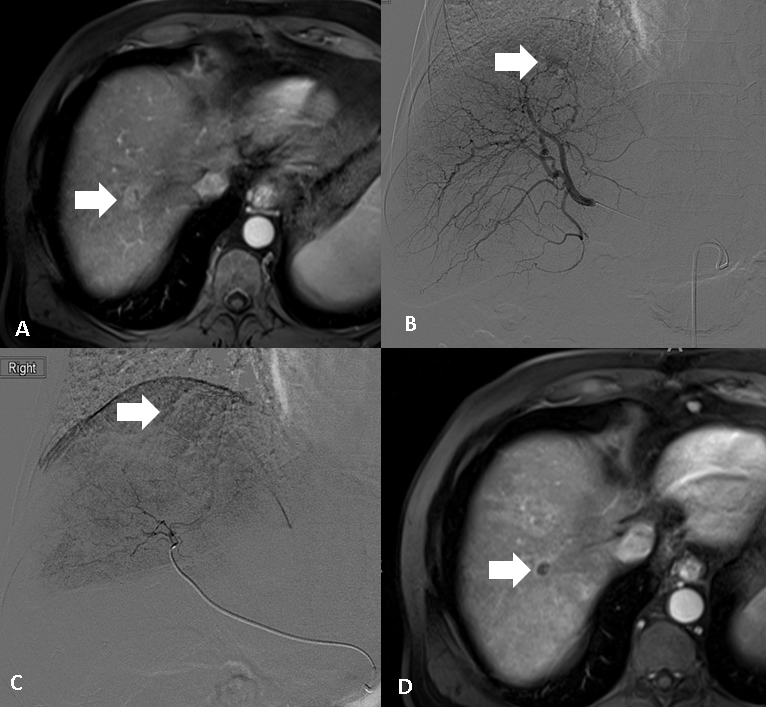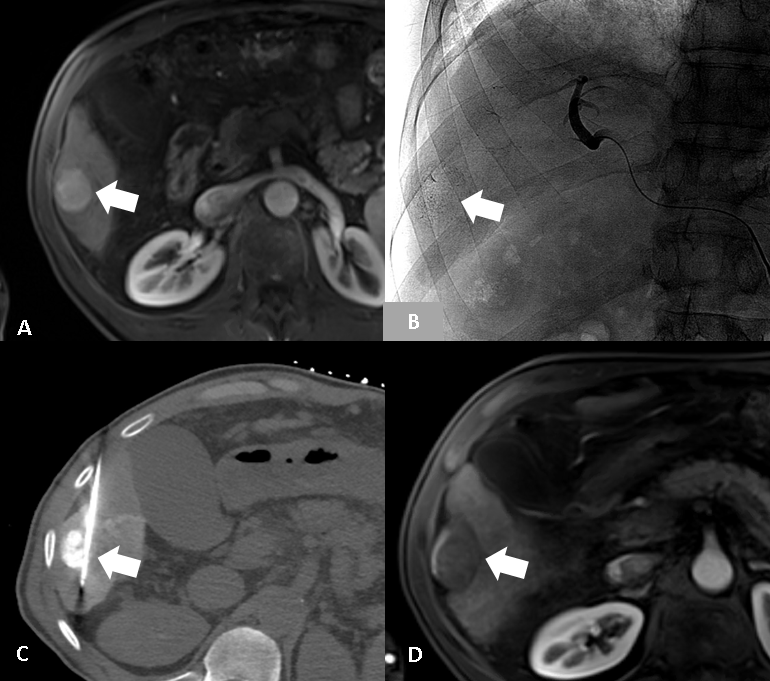Current Perspectives on the BCLC Staging System for Hepatocellular Carcinoma
Reviewing recent changes to the Barcelona Clinic Liver Cancer (BCLC) staging system for hepatocellular carcinoma and the potential impact for interventional radiologists, these authors discuss key updates including the subdivision of patients with intermediate stage disease and emerging literature on systemic agents for advanced disease.
Hepatocellular carcinoma (HCC) is one of the deadliest cancers with a five-year survival rate of 21 percent.1 It is imperative for experts to continually seek new strategies and therapies to improve care for patients with HCC. Along these lines, the Barcelona Clinic Liver Cancer (BCLC) system is the most widely used system for staging HCC.2 The BCLC system takes performance status (PS) and liver function into account as well as factors such as tumor size, number, vascular invasion, and extrahepatic metastases while providing treatment recommendations and expected outcomes for each stage.
Major updates to the BCLC guidelines were published in 2022.2 For interventional radiologists, some of the new recommendations could have a significant impact on their practice. Accordingly, let us take a closer look at three important changes to the BCLC guidelines that interventional radiologists should be aware of when considering therapeutic strategies for patients with HCC in a multidisciplinary setting. These changes include: 1) the subdivision of patients with intermediate stage (stage B) disease; 2) the inclusion of transarterial radioembolization (TARE) within the guidelines; and 3) the introduction of new systemic agents for patients with more advanced stages of disease.
Key Considerations with the Subdivision of Intermediate Stage Disease
Patients with intermediate stage, or stage B, disease have multifocal, unresectable HCC with well-preserved liver function and no significant cancer-related detriment to their activities (PS of 0). Moreover, disease is contained entirely within the liver without main portal vein invasion or evidence of extrahepatic metastasis. Prior to the 2022 update, patients with stage B HCC were typically treated with either conventional or drug-eluting bead transarterial chemoembolization (TACE).
Patients with Stage B disease are now subdivided into three clinically distinct cohorts based on liver function and tumor burden (see Figure 1). The first cohort consists of patients who, based on tumor burden and alpha-fetoprotein (AFP) levels, may qualify for liver transplantation according to expanded liver transplant criterion. This is a major advance for these patients as liver transplantation provides the best long-term overall survival for patients with HCC.3 Along these lines, any liver-directed therapy in this subgroup could be considered as bridging to transplant.
Figure 1. Three subgroups of patients with intermediate stage (or stage B) HCC. Adapted from Reig M, Forner A, Rimola J, et al. BCLC strategy for prognosis prediction and treatment recommendation: The 2022 update. J Hepatol. 2022;76(3):681-693.

The second cohort of patients with Stage B disease includes patients with well-defined HCCs and preserved portal venous flow. Similar to previous guidelines, these patients should still be treated with TACE with the goal of downstaging the patient to be within transplant criteria. In our practice, we typically use drug-eluting bead TACE (see Figure 2) due to lower cost, less toxicity, and less post-procedure pain.4 We reserve conventional TACE for patients undergoing percutaneous ablation (see Figure 3) or stereotactic body radiation therapy (SBRT) in combination with TACE.5,6
Figure 2. 63-year-old male with cirrhosis. A) Contrast-enhanced MRI in arterial phase shows a 2 cm enhancing lesion near the dome (arrow), consistent with HCC. Due to the location of the lesion, the patient was treated with drug-eluting bead transarterial chemoembolization (DEB-TACE). B) Digital subtraction angiography with the microcatheter in right hepatic artery shows the hypervascular HCC in the dome (arrow). C) Digital subtraction angiography after DEB-TACE shows no residual flow to the tumor (arrow). D) Contrast-enhanced MRI in arterial phase obtained approximately four weeks after DEB-TACE shows a complete response to treatment (arrow).

The final subgroup with stage B includes patients with diffuse, infiltrative, and/or extensive bilobar involvement. For these patients, systemic therapy is now recommended as the first-line treatment with a bevy of newly approved agents now available. These agents will be discussed in more detail below. Currently, our multidisciplinary workflow for these patients includes approximately six months of systemic therapy. If the patient is tolerating it well with a good radiographic response, we subsequently move on to consolidative liver-directed therapies including TACE or TARE.
Figure 3. 64-year-old male with cirrhosis. A) Contrast-enhanced MRI in arterial phase shows a 3.5 cm enhancing mass in the inferior right lobe (arrow), consistent with HCC. B) Angiography performed after conventional TACE shows no blood flow in the right hepatic artery with the chemotherapeutic agent in the tumor (arrow). C) CT obtained during percutaneous microwave ablation shows the tumor, now hyperdense with chemotherapeutic agent, and the microwave ablation needle (arrow). D) Contrast-enhanced MRI in arterial phase obtained approximately four weeks after DEB-TACE shows a complete response to treatment (arrow).

(Editor’s note: For related content, see “Is Follow-Up Pelvic CT Coverage Necessary for Patients Treated for Hepatocellular Carcinoma?” and “Abbreviated MRI and Early-Stage Hepatocellular Carcinoma: What a New Multicenter Study Reveals.”)
What Recent Studies Revealed About Transarterial Radioembolization
Although TARE has been in clinical use for patients with both primary and metastatic liver malignancies for several years (see Figure 4), it was not approved by the Food and Drug Administration (FDA) in the United States for HCC until 2021. TARE is now listed a treatment option for patients with either very early stage (stage 0) or early stage (stage A) disease if transplant, resection, or percutaneous ablation are not feasible or are unsuccessful. In keeping with the traditional utilization of TAE, the new guidelines also list it as a possible treatment for patients with stage B disease, either as an alternative to TACE or as an additional intra-arterial therapy if TACE fails.
Figure 4. 68-year-old male with cirrhosis and biopsy-proven mixed HCC-cholangiocarcinoma. A) Contrast-enhanced MRI in arterial phase shows the small lesion in segment 8 of the liver (arrow). B) Cone-beam CT obtained during the TARE mapping procedure shows localization of the artery supplying segment 8 (arrows). C) SPECT-CT obtained after TARE shows excellent uptake of the radiation within segment 8 (arrow). D) Subtracted image from a contrast-enhanced MRI in arterial phase obtained approximately three months after TARE shows necrosis of segment 8 without residual disease (arrow).

The inclusion of TARE in the updated BCLC guidelines comes after the publication of several exciting studies. Data from the multicenter, retrospective, single-arm LEGACY trial demonstrated a three-year overall survival of 86.6 percent in all patients (162) in addition to an overall survival of 92.8 percent for those patients who subsequently underwent either resection or liver transplantation.7 Importantly, complete pathologic necrosis was achieved in all resected HCC specimens that received a dosage exceeding 400 Gy, confirming both the safety and efficacy of TARE doses.
In the DOSISPHERE-01 study, a phase II, multicenter, prospective, randomized trial comparing standard TARE dosimetry models to “personalized” dosimetry models, researchers showed a 16-month improvement in overall survival for patients treated with personalized dosimetry.8 Dosimetry models are an active area of research, and additional investigation is warranted to optimize patient selection and dosing.
The phase II, randomized, prospective TRACE trial sought to compare TARE and TACE in patients with HCC.9 This trial was the first to show an overall survival benefit in patients treated with TARE (30.2 months vs. 15.6 months).
A Closer Look at New Systemic Agents for Advanced Stage HCC
Patients with advanced stage (or stage C) HCC have either invasion of the portal venous system, extrahepatic disease, or a PS ≥1. Previously, patients with stage C were primarily treated with sorafenib, a tyrosine kinase inhibitor, which was generally not well-tolerated and provided minimal benefits to overall survival.
There are now at least two immunotherapeutic regimens that can be used for stage C HCC in place of sorafenib. The IMbrave150 trial was a prospective, randomized, phase III trial comparing atezolizumab plus bevacizumab (atezo/bev) to sorafenib in patients with treatment-naïve, unresectable HCC.10 The study included 336 patients in the atezo/bev group and 165 patients in the sorafenib group. Patients treated with atezo/bev demonstrated longer overall survival at 12 months (67.2 percent vs. 54.6 percent) and longer progression-free survival (6.8 vs. 4.3 months). Rates of grade 3 or 4 adverse events were similar between the two groups. As a result, atezo/bev is recommended over sorafenib in Stage C HCC.
The HIMALAYA trial was a three-arm, prospective, randomized trial comparing tremelimumab plus durvalumab (treme/durva), single agent durvalumab, and sorafenib in treatment-naïve patients with unresectable HCC.11 The study enrolled over 1,000 patients in several countries. Investigators reported a 22 percent reduction in mortality for patients who received the combination therapy with three-year overall survival rates of 30.7 percent for patients treated with treme/durva, 24.7 percent for those treated with treme alone and 20.2 percent in the sorafenib group. The overall response rate was also higher in the combination arm (20.1 percent) than the single agent arms of either tremelimumab alone (17 pecent) or sorafenib (5.1 percent). Based on these results, the treme/durva combination is also approved for patients with stage C HCC.
Future directions will examine how systemic therapies can be combined with either TACE or TARE to improve outcomes. For instance, one trial has already shown that TACE combined with sorafenib improved progression-free survival compared to sorafenib alone.12 Other studies, including EMERALD-1, EMERALD-3, and ROWAN, will continue to expand knowledge on safety, timing, patient selection, and efficacy of combined approaches.
In Conclusion
There have been major developments to the BCLC guidelines for the management of HCC. Interventional radiologists should be abreast of these changes to provide state-of-the-art, collaborative care for their patients.
Mr. Babar is a student at the Alabama College of Osteopathic Medicine in Dothan, Alabama.
Dr. Gunn is the director of Interventional Oncology, an associate professor in the Division of Vascular and Interventional Radiology and the program director of the Integrated IR Residency Program in the Department of Radiology at the University of Alabama at Birmingham.
Dr. Gunn has disclosed that he is a speaker and consultant for Varian, Boston Scientific, and Penumbra, and receives research support from Varian and Penumbra.
References
1. International Agency for Research on Cancer. Liver. https://gco.iarc.fr/today/data/factsheets/cancers/11-Liver-fact-sheet.pdf. Published 2018. Accessed February 22, 2023.
2. Reig M, Forner A, Rimola J, et al. BCLC strategy for prognosis prediction and treatment recommendation: The 2022 update. J Hepatol. 2022;76(3):681-693.
3. Lai Q, Viveiros A, Iesari S, et al. Prognostic factors for 10-year survival in patients with hepatocellular cancer receiving liver transplantation. Front Oncol. 2022;12:877107. doi:10.3389/fonc.2022.877107.
4. Li H, Wu F, Duan M, Zhang G. Drug-eluting bead transarterial chemoembolization (TACE) vs conventional TACE in treating hepatocellular carcinoma patients with multiple conventional TACE treatments history. Medicine. 2019;98(21):e15314. doi:10.1097/md.0000000000015314.
5. Zhang YJ, Chen MS, Chen Y, Lau WY, Peng Z. Long-term outcomes of transcatheter arterial chemoembolization combined with radiofrequency ablation as an initial treatment for early-stage hepatocellular carcinoma. JAMA Netw Open. 2021;4(9):e2126992. doi:10.1001/jamanetworkopen.2021.26992.
6. Jacob R, Turley F, Redden DT, et al. Adjuvant stereotactic body radiotherapy following transarterial chemoembolization in patients with non-resectable hepatocellular carcinoma tumours of ≥ 3 cm. HPB (Oxford). 2015;17(2):140-149.
7. Salem R, Johnson GE, Kim E, et al. Yttrium‐90 radioembolization for the treatment of solitary, unresectable HCC: the LEGACY study. Hepatology. 2021;74(5):2342-2352.
8. Garin E, Tselikas L, Guiu B, et al. Personalised versus standard dosimetry approach of selective internal radiation therapy in patients with locally advanced hepatocellular carcinoma (DOSISPHERE-01): a randomised, multicentre, open-label phase 2 trial. Lancet Gastroenterol Hepatol. 2021;6(1):17-29.
9. Dhondt E, Lambert B, Hermie L, et al. 90Y radioembolization versus drug-eluting bead chemoembolization for unresectable hepatocellular carcinoma: results from the TRACE phase II randomized controlled trial. Radiology. 2022;303(3):699-710.
10. Finn RS, Qin S, Ikeda M, et al. Atezolizumab plus bevacizumab in unresectable hepatocellular carcinoma. N Eng J Med. 2020;382(20):1894-1905.
11. Abou-Alfa GK, Lau G, Kudo M, et al. Tremelimumab plus durvalumab in unresectable hepatocellular carcinoma. NEJM Evidence. 2022;1(8). doi:10.1056/evidoa2100070 . Published June 6, 2022.
12. Kudo M, Ueshima K, Ikeda M, et al. Final results of TACTICS: a randomized, prospective trial comparing transarterial chemoembolization plus sorafenib to transarterial chemoembolization alone in patients with unresectable hepatocellular carcinoma. Liver Cancer. 2022;11(4):354-367.
MRI Study Suggests Shape of White Matter Hyperintensities May Be Predictive of Cognitive Decline
April 7th 2025Emerging research demonstrated that cognitive declines in memory, executive function and processing speed domains were associated with irregular shape of periventricular/confluent white matter hyperintensities.
Can Photon-Counting CT be an Alternative to MRI for Assessing Liver Fat Fraction?
March 21st 2025Photon-counting CT fat fraction evaluation offered a maximum sensitivity of 81 percent for detecting steatosis and had a 91 percent ICC agreement with MRI proton density fat fraction assessment, according to new prospective research.










